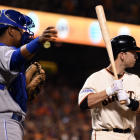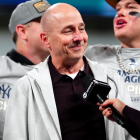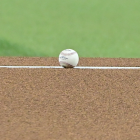It’s admittedly not a scintillating turn of events, when it goes as planned. The catcher stands there like a railroad semaphore, the catcher lobs four apologetic-looking pitches wide of the plate, the catcher shuffles out of the box to secure them, and the duly respected hitter ambles down to first base. It takes a little time -- it took a little time merely to describe it -- and MLB under commissioner Rob Manfred is nothing if not hell-bent bleeding the game dry of downtime.
That’s why MLB and the players association have agreed to snuff out the intentional walk as we know it. No more will that halting sequence above corrupt the pace of play. Instead, the team issuing the free pass will simply state its intentions, and then it will be done automatically, albeit not for the people.
While this makes some sense and is already the way of doing things at some other levels of organized baseball, we’re losing something. That something is the threat of the haphazard, the unintended, even the miraculous. To be sure, the intentional walk didn’t go awry often or otherwise confront our assumptions, but the rarity of those outcomes is what makes them memorable. So much for that.
So much for what? We speak -- ruefully, given recent decisions from on high -- of lightning strikes such as these ...
When the hitter decides not to cooperate
Look, no one says the batsman must be passively cooperative when the IBB comes his way. The most towering example of a hitter who decided to take back the streets comes to us courtesy of Ole Miss’ Austin Anderson, who in April of 2014 dry-gulched Auburn in the bottom of the 13th inning ...
And the people say: Larduhmighty. Anderson had been intentionally walked twice already in that game, and the above sports-action footage suggests that his personal IBB quota had been reached.
While nothing as high-stakes as that has happened in the majors, at least as far as we know, a future first-ballot Hall of Famer once perpetrated something similar ...
Miggy don’t play. But that’s all gone now.
When it’s not as easy as it looks
Under the old way of issuing a free pass, you were in essence asking the pitcher to do something at once basic and contrary to his muscle memory. Throw a pitch but make it really slow and put it way out of the strike zone while still being catchable, was the directive. In other words, make a ceremonial first pitch. Such a departure from the usual job description usually worked out fine, but sometimes it didn’t.
One of those times was, oh, Tuesday night not long after we learned of the changes of note. As such, what you’re about to see wasn’t written in the stars but rather hurriedly scrawled on a sticky note and slapped on a star not long after the news broke ...
More collegiate whimsy, you say? Yes, but know that this kind of thing has also been unfurled at the highest level. Steve Cishek, your life is calling ...
That’s some less-than-timely arm-side run right there. But that’s all gone now.
When it’s a con job
As a few chagrined hitters have learned over the years, the precursory IBB rituals don’t necessarily mean the IBB is coming. No less a hitter than Johnny Bench certainly learned this lesson against the A’s in the 1972 World Series ...
Excelsior! Also know that Tony Pena helped pull this off on multiple occasions. For darn instance ...
iViva la subterfuge! As well, very gentlemanly of Mr. Pena to help out Blue with the punch-out. But that’s all gone now.
We could go on, of course. The examples are rare, but they happen, and the mere threat of them is enough to add just a bit of pressure to the IBB participants. Or at least that was the case until now.
Is not something lost by knowing these things will never happen again in MLB? Sure, IBBs gone rogue lightly pepper the sprawl of baseball history, but they stay with us. We’ll always have Rollie Fingers’ slow-playing Johnny Bench in the World Series, but something like that will never come our way again.
And to what end? The intentional walk happened 932 times in the majors last season. While that sounds like a notable tally, remember that those 932 IBBs took place across 2,428 games. In other words, in 2016 we witnessed an average of 0.38 intentional walks per game. Suffice it to say, this is not a leading cause of baseball’s pacing problems (I’d deny the premise that baseball even has a pacing problem, but that’s another discussion). So we’ve scrubbed away all the possibilities above in order to speed up something that happens not quite once every 2.5 games.
Boo to that, it says here.

















